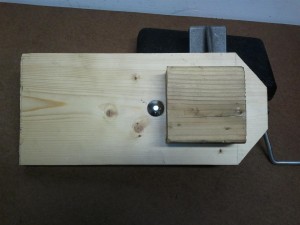My Pontiac 400 engine rebuild requires me to file to fit the top 2 compression rings. In order to make sure the rings keep their true edge, a mechanical Piston Ring Filer is recommended. Because I do not plan on using this tool very often, I decided to purchase an inexpensive clone from Jegs. A quality name brand (KD Tools) version of this filer is available at Amazon.com for only a couple bucks more.
The Piston Ring Filer will come with a bracket to allow you to bolt it to your workbench. Rather than bolting it to my bench, I decided to build my own platform to permanently mount the piston filer to, that way I could mount it in my bench vise when needed. I used a 1 x 6 cut about 14 inches long, with two 45 degree cuts at one end so my knuckles do not hit the wood during cranking. I then cut a 2 x 4 at 3 1/2 inches making a square block to screw to the bottom of the filer platform for pinching with my vise. The result is pictured.
To file a piston ring, place the ring facing up on the tongue end of the filer tool with the open ends of the ring resting within the side by side wheel bearings. With either one or both sides of the ring pressed lightly into the filing wheel, rotate the wheel counter clockwise so the wheel moves against the ring in a down and inward pattern. This will leave the top and outer edge with no rough edges. I’ve viewed one engine builder use this ring filer to file only one end of the ring, leaving the other end slightly away from the grinding stone. Filing only one end of the ring has the advantage of allowing you to compare the filed end with the non-filed end to verify the edge is true.
You can file rings with a hand file, but you take the chance of filing the end of the ring unevenly. If you’re paranoid like me, drop the $50-70 on one of these ring filers, it’s a no-brainer.


